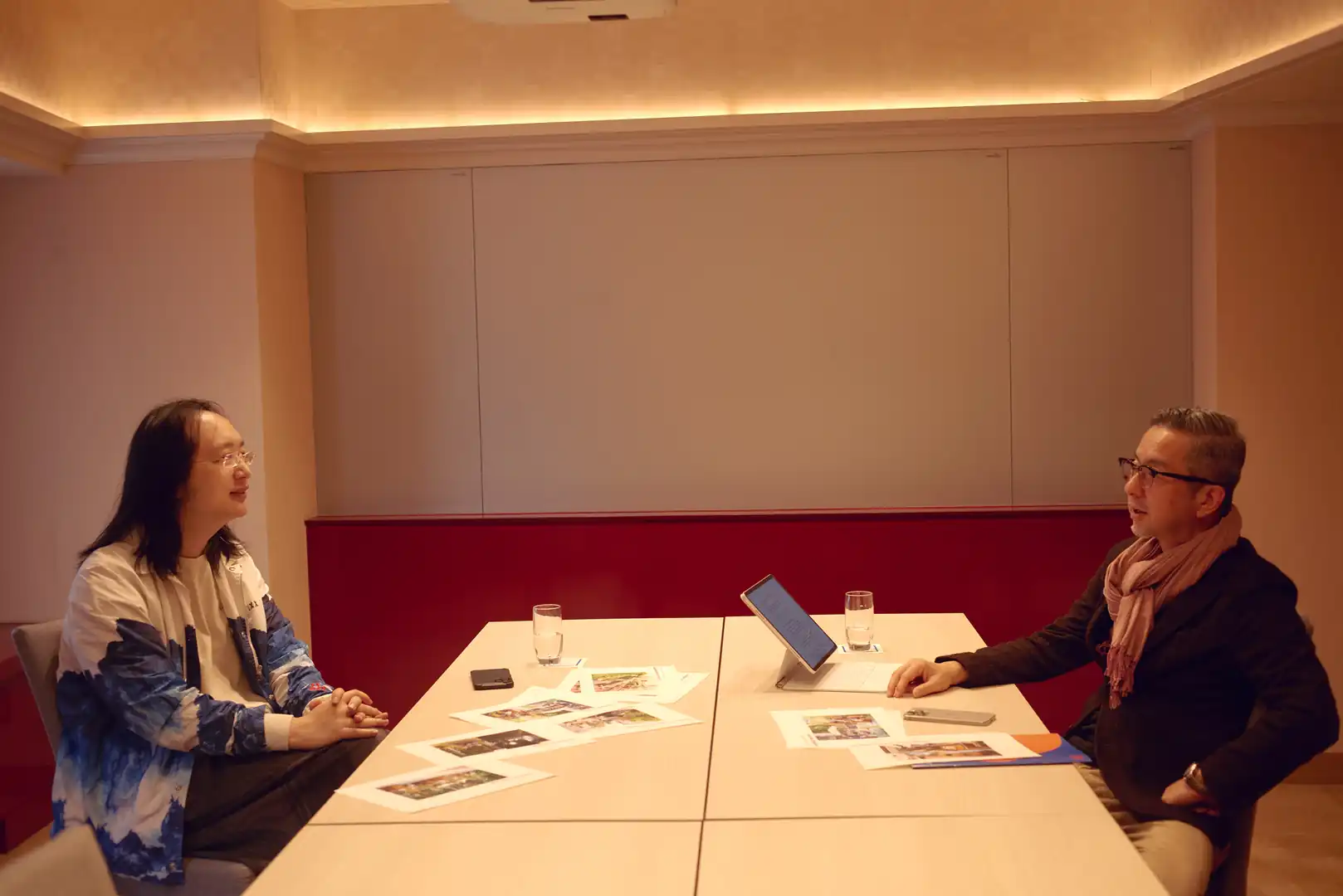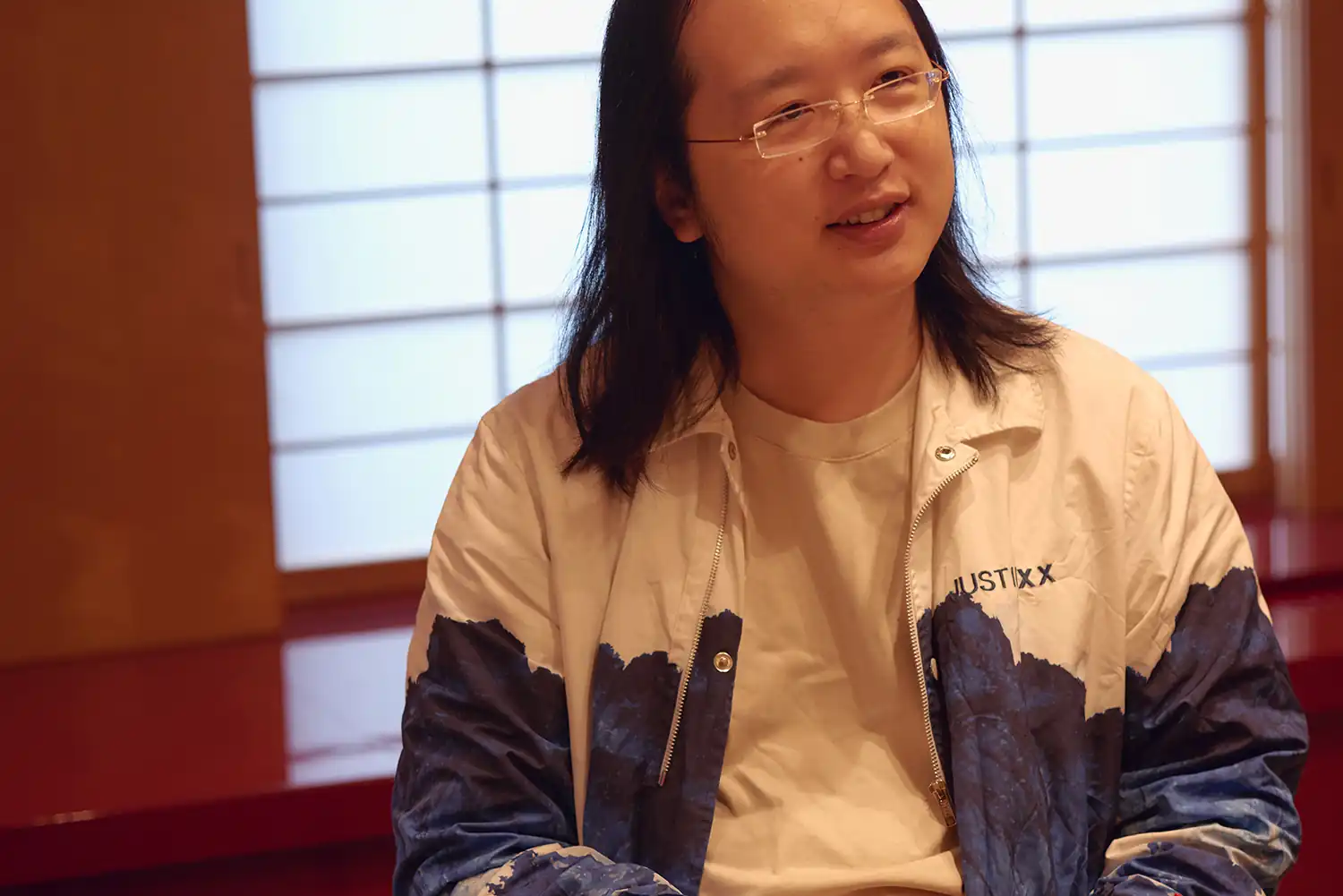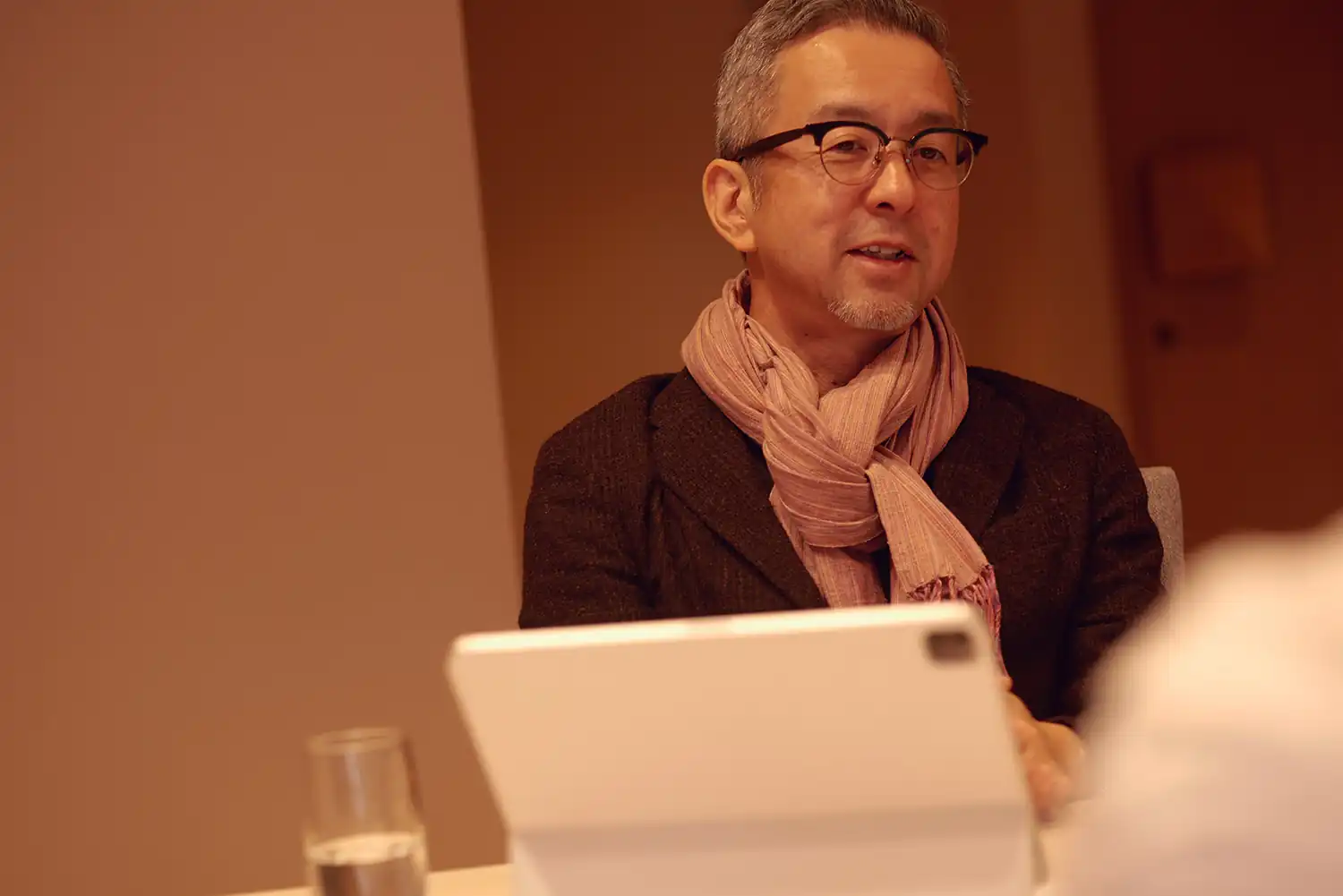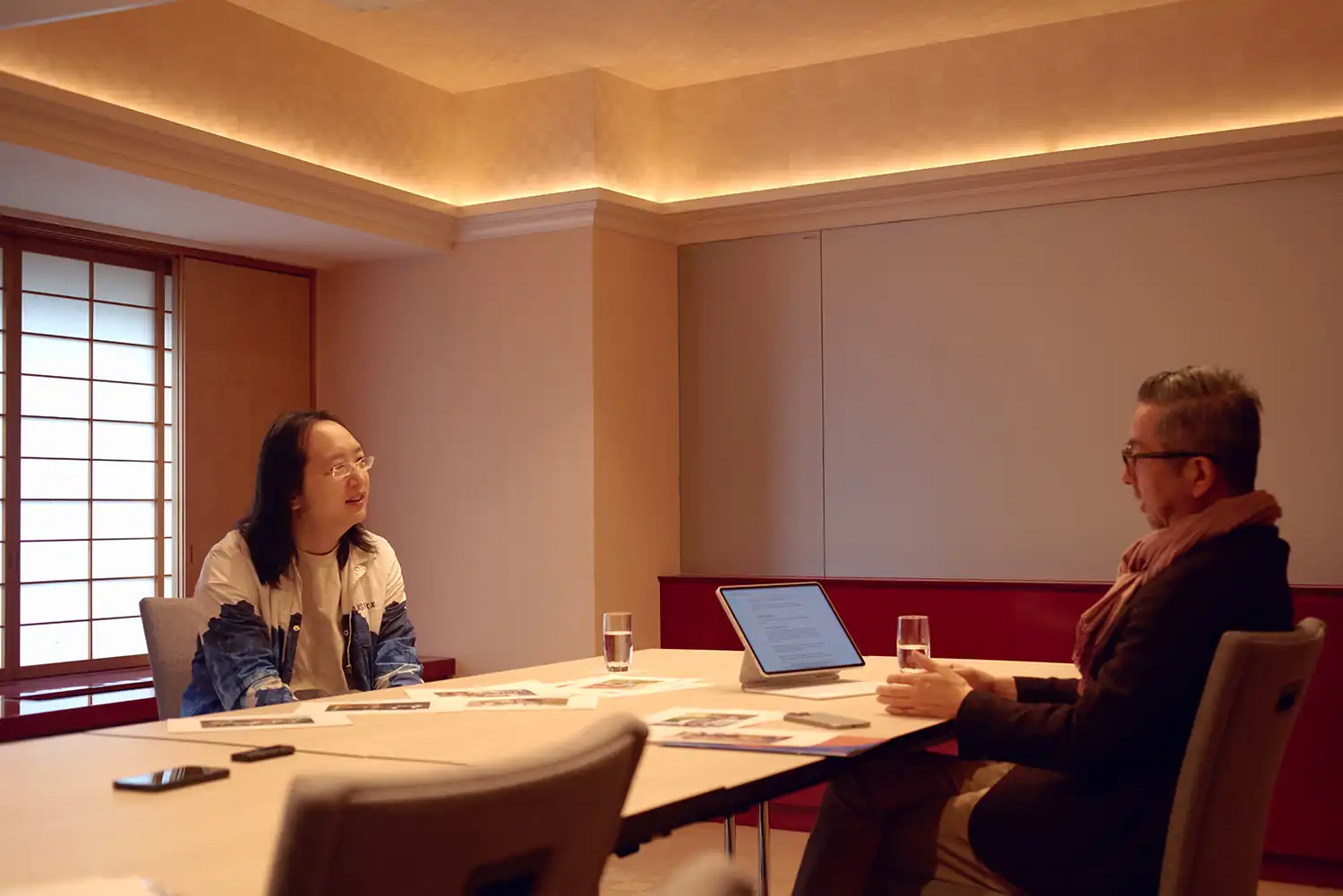
What challenges should designers face now, as found at the GOOD DESIGN AWARDs.
FOCUSED ISSUES is a GOOD DESIGN AWARD initiative that depicts the future of design in society through the screening process.

2024 FOCUSED ISSUES
Considering “A Small Step, Design Leaps”
Collaboration and Co-creation in Design from the Perspective of Plurality: Audrey Tang and Naoki Ota
2025.02.17
The Focused Issues report, summarizing the proposals for 2024, will be released soon. Naoki Ota, a researcher involved in the project, presented the proposal “Create a chain of small challenges under a flexible vision.” To explore this idea further, he reached out to Audrey Tang, Taiwan's first Digital Minister, for a dialogue. Due to space limitations, some episodes could not be included in the report. However, we are releasing the full dialogue in advance.
In this age of division and conflict, how can we design technologies that facilitate collaboration and co-creation? The discussion focused on the path to transforming challenges into energy to create the future.
Unrevised rules are like rituals or myths
Ota: When you visited Manazuru, where I live, some time ago, you asked how the citizens living in the town revise the rules for community development, particularly the town planning ordinance called “美の基準 (Design Code),” based on pattern language.
Today, connecting with each other, we are able to make small changes to rules at any time. And those small changes can lead to big changes. Yet, many people consider following the rules the most important or never imagine possibilities that changes bring.
I believe your question, “How do citizens revise the rules?” is closely related to my proposal, “Create a chain of small challenges under a flexible vision.”
Tang: If rules are not revised, they would become something like rituals or myths. It’s like this situation: Everyone there can speak English, so they can communicate in English. But if they don’t know the others speak English, they won’t speak English there unless somebody suggests it.

Ota: Indeed. To address this issue, let me introduce some of the works that won the 2024 GOOD DESIGN AWARD and caught my attention, before we get into the main subject.
The first one is “IKEBUKURO LIVING LOOP.” In Ikebukuro, home to Japan's third-busiest rail station, several regional revitalization projects have been conducted, but they have not led to tangible results. But in 2017, a person who grew up in Ikebukuro took the initiative to reform the local community.
The reforms connected individuals, local businesses, and local government staff in the city where personal connections were scarce. The Ikebukuro citizens rethink streets and parks as the living rooms of the city and spend time there in a comfortable atmosphere. I think it is worth pointing out that local governments have become more flexible in reviewing policies regarding the use of roads and parks.
https://www.g-mark.org/en/gallery/winners/26336Tang: The colors and affordances seem to blend well. The living room is connected to other rooms (places) and is a welcoming place. Representing it on a main street might result in changing the definition of “street.” It seems that the street connects people to others, instead of connecting them to the next destination.
Ota: That's true. A street used to be just a means to move from point A to point B, but people now spend a lot of time there relaxing or socializing.
The other work that I would like to introduce is the “Babakkawa Street Urban Design Project.” This is the first project in Japan to renovate a 200-meter city-owned road with private funding and planning in cooperation with the government. This city has the largest river to provide water to the Tokyo metropolitan area. Long ago, people in this city enjoyed the rich water and nature, but due to the postwar urbanization, the waterways were paved and the city became more car-centric. However, some citizens stood up and took action to transform these roads into a relaxing space connected to waterways.
Tang: That's wonderful. If it is implemented by the private sector, there is no need to wait for the budget cycle of the local government.
https://www.g-mark.org/en/gallery/winners/27150Our goal is to “Free the Future”
Ota: Based on my three years of experience working in government administration, I wonder why it is often difficult for municipalities and administrative bodies to change rules flexibly. Are these two award-winning projects exceptional cases?
Tang: I think the government is concerned whether changing rules really leads to more people participating in the public sector. Once it is clear that a rule change benefits only a specific group, it's hard to reverse, especially if private organizations or groups are in charge of the project. In addition, for many large-scale top-down construction projects, it is often impossible to revise the rules later.
Therefore, I think we should adopt what I call “Free the Future.” It’s about creating an environment where the next generation can act with greater flexibility and mobility. This would make it easier for many public services to change rules.
Ota: What is the current situation in Taiwan in terms of people's attitudes toward changing rules?
Tang: Even during the undemocratic martial law period in the late 20th century, Taiwan had many grassroots organizations at the community level. There was an understanding among people that they could solve community problems without having to vote out the mayor. This norm has been common in Taiwan for quite some time, and it exists in a way that complements the state. In that sense, I think people's actions are not what are imposed on them by the state or by voting behavior, but are nurtured from the grassroots.
Ota: While some believe that group thinking, in which people discuss matters in a group like a community, provides many opportunities, others think it is not very useful.
Tang: I think it depends on the diversity of the group. Small groups of 3 to 5 people can reflect diversity. However, when the group has 5,000 people, tracking diversity becomes difficult. This is where AI and other digital technologies come into play. For example, I think it would be effective to start by forming a group of 3 to 5 people, allowing them to talk comfortably, and then use the technologies to connect these groups or create a place where they can resonate with each other.
Ota: In reality, however, many countries have yet to become societies that fully accept diversity. What factors do you think prevent the realization of such a society?
Tang: If people have a bad experience when exposed to diversity, then it creates negative effects. Because of this experience, the next time you see someone different from you, you project them to be much more extremely different than they really are.
Social media, in particular, makes it easy for extreme views to go viral. This leads to misunderstandings about people with different opinions, like assuming “They hate us.” If these reactions keep growing, even if they don’t lead to violence, they result in a cycle of polarization, in which people keep a distance from each other and become estranged.
Now, how can design address diversity? I think having people experience diversity in different settings is more important than telling them that diversity is good. I believe that sharing a space can help people create a perception that it’s a safe place and, in the long run, promote an understanding of diversity.
The new norm of collaboration in the post-Internet generation
Ota: Based on the trends in the award-winning works, the Focused Issues team of the GOOD DESIGN AWARD in fiscal 2024 has set the theme, “A Small Step, Design Leaps.” The theme reflects a perspective that new designs often start with individual ideas rather than big ideas led by market demand. For example, the two cases that I introduced and also many other award-winning works were created from new designs and ideas by individuals without a master plan. Why do you think these trends have emerged?

Tang: Thanks to the Internet, now individuals with various ideas can connect with stakeholders, much more effectively than in top-down organizations. I mean, the reversal of the organizing principles due to digital technology can be a big contributing factor.
Especially for generations who grew up with the Internet and are familiar with online games like World of Warcraft and Minecraft, collaborating with people far away is an everyday activity. This shift in norms, where sharing values and collaborating with strangers have become common, is as significant as the changes in technology.
When I was young, my parents told me not to ride in a stranger's car or stay at a stranger's house, but now Uber and Airbnb are accepted as common services. Everything is organized around this new principle: strangers with shared values co-create something.
Ota: From our experience, the Great East Japan Earthquake of 2011 was a turning point. The disaster led people to start actively using social media and connect with each other in different ways. Since then, as you say, the community has become broader and deeper than expected.
On the other hand, if you look at social media, even though we are connected, those connections are often exclusive or divided. What do you think about these situations, often explained by concepts like “echo chambers” or “filter bubbles”?
Tang: The situations vary depending on which social media you are talking about. X uses a personalized algorithmic feed, which separates users and makes it less likely for them to form broader connections. I'd like to point out that services like GitHub and Linkedin operate under a different set of norms and connect users in a different way.
Ota: Four years ago, you discussed the topic, “hacking or being hacked,” with Yuval Noah Harari, the author of “Sapiens: A Brief History of Humankind.” You also talked about algorithms and AI then.
Tang: In short, he argued that we might eventually become puppets of algorithms. In response to this opinion, I believe that two countermeasures are required.
The first measure is to increase human autonomy. Instead of accepting 100% of what your AI coaches or therapists say, you can make adjustments if you don't like their advice. Feedback loops with multiple AI systems should help humans grow.
The second measure is to connect with people and form a community. Let me compare forming human relationships to building muscle. You have to physically go to the gym to train yourself. You will never develop your muscles If you just listen to an AI robot saying, “I'll lift it for you, and all you have to do is watch.” The ability to build human relationships has to be nurtured without deferring to AI.
“Plurality,” a thought that transforms conflict into co-creation
Ota: In your book published in 2024, you proposed a vision called “Plurality” (a word meaning “pluralism” and “diversity”). Finally, I would like to discuss the future of design, keeping this vision in mind.
Tang: The idea of “Plurality” is simple. Basically, I believe conflicts arising from diversity are features, not bugs. Conflict can be turned into co-creation. “Plurality” is an idea for achieving it with digital technology. For example, you pointed out earlier that the Great East Japan Earthquake was a turning point that led to a wider spread of technology into society. Natural disasters can surely cause enormous damage. However, without such disasters, people might not have realized their potential.
One of the key technologies for such co-creation is “Civic Tech.” (Editor’s note: Initiatives and technologies that enable citizens to solve local problems, utilizing digital technology) If this idea spreads, everyone can become a designer to create a better future. In an emergency like a disaster, utilizing technology can help us stay calm, bring together human energy, and come up with solutions. If more and more people gain access to those tools, it will support and enhance diversity.
In recent years, AI has also become increasingly useful as a translation tool. Until now, not so many people may have been able to draw a detailed picture of their vision. I guess most people were better at speaking or writing about it. But now, generative AI can beautifully turn your vision and ideas into pictures and diagrams. If more people start to use this translation tool in the future, we will be able to build better collaborative relationships across different modalities and cultures.
Ota: That's a highly innovative shift in perspective, addressing not only behavior but also mindset. Earlier, we discussed factors that make diversity challenging, and the idea that “Plurality” can turn conflict into the energy for co-creation is truly remarkable. That said, if we were to intentionally consider the potential side effects or pitfalls associated with co-creation, what might they be?
Tang: Accessibility would be a classic issue. Even if we had a digital democracy platform, it would be meaningless if one-third to half of the population didn't have access to the necessary devices. In this situation, people are divided into the “co-creative class” and the “non-co-creative class.” That's why it's important to always have the perspective that we might be leaving someone behind.
In that respect, I think Japan is excellent. I sometimes see news that Japan ranks between 20th and 30th in the world in terms of digital penetration rates. This may give the impression that Japan is lagging behind in digital transformation (DX), but this is not a race. The development and penetration of technology is like navigating a winding mountain pass through chaos and disasters. If the path is unstable in the first place, you don’t want to run at full speed, because you might fall off a cliff. You should move forward at the right speed, while keeping control and flexibility.

Ota: Your view is very encouraging.
Tang: If you're not running at full speed, everyone can keep up, and no one will be left behind. This opens up more possibilities. You should widen the road rather than narrow it. This way, people will feel safer and be less likely to fall into traps.
What people fear most now is not that their jobs will be taken over, but that their decisions will be controlled by AI. Each person can surely try to hone their skills and reskill. In order to align AI to a society, it's important not to leave anyone behind. Proceeding at the right speed is crucial to avoid limiting co-creation to just a few people.
Ota: Your view is really encouraging me, as Japan has clearly been losing ground in many ways. But, what you said makes me believe that we can create the future by turning conflict and challenges into energy.
Tang: I believe that Japan has one of the world’s best capabilities when it comes to fostering relationships between communities. Even in the event of a disaster, no one wants to profit from it. Even the largest corporations cannot survive in Japanese society if they are perceived as selfish.
That's why Japan aligns well with my idea of “Plurality.” “Plurality” has the potential to be a collaborative force for social cohesion and consensus, ensuring that no one is left behind.
A report summarizing this year’s Focused Issues activities will be published in this journal soon. It highlights key discussions, including the recent expert roundtable, and brings together insights from six directors and researchers who examined a wide range of entries. The report also presents concrete actions as proposals. We hope you look forward to this deep dive into a year of exploration!
Audrey Tang
Former Digital Minister of Taiwan (Cabinet Minister). Born in Taipei, Taiwan in 1981. At the Tsai Ing-wen administration, at the age of 35, the youngest ever, she was appointed to the Executive Yuan (Cabinet) as Digital Minister, and was responsible for leading open government, social innovation, and youth engagement across departments.
Naoki Ota
Co-creation Partner New Stories Ltd. CEO
Until 2014, he was a management member of Boston Consulting, overseeing the Technology Group in Asia. From 2015 to 2017, he was an assistant to the Minister of Internal Affairs and Communications, working on digital strategy and regional development. In 2018, he launched New Stories Ltd. to create future value leveraging his expertise and network. He helps to create communities that leverage technology.
Ryo Hasegawa
Writer
Hasegawa assists with writing structure and articulation, supporting individuals, companies, and media in their communications, with a focus on technology, management, and business-related content. Notable editorial collaborations include The Future of Work in 10 Years (Takafumi Horie & Yoichi Ochiai), The Evolution of Japan (Yoichi Ochiai), THE TEAM (Koji Asano), and The Formula for Career Success (moto), among others. His background includes studying at the University of Tokyo (Interfaculty Initiative in Information Studies), working at Recruit Holdings, becoming independent, spending three years playing poker in Africa, and continuing his career today.
Shunsuke Imai
Photographer
He was born in Minamiuonuma City, Niigata in 1993. He became independent after working for amana Inc.
Masaki Koike
Editor
Editor. He does planning and editing in multiple media, mainly in collaboration with researchers and creators.


